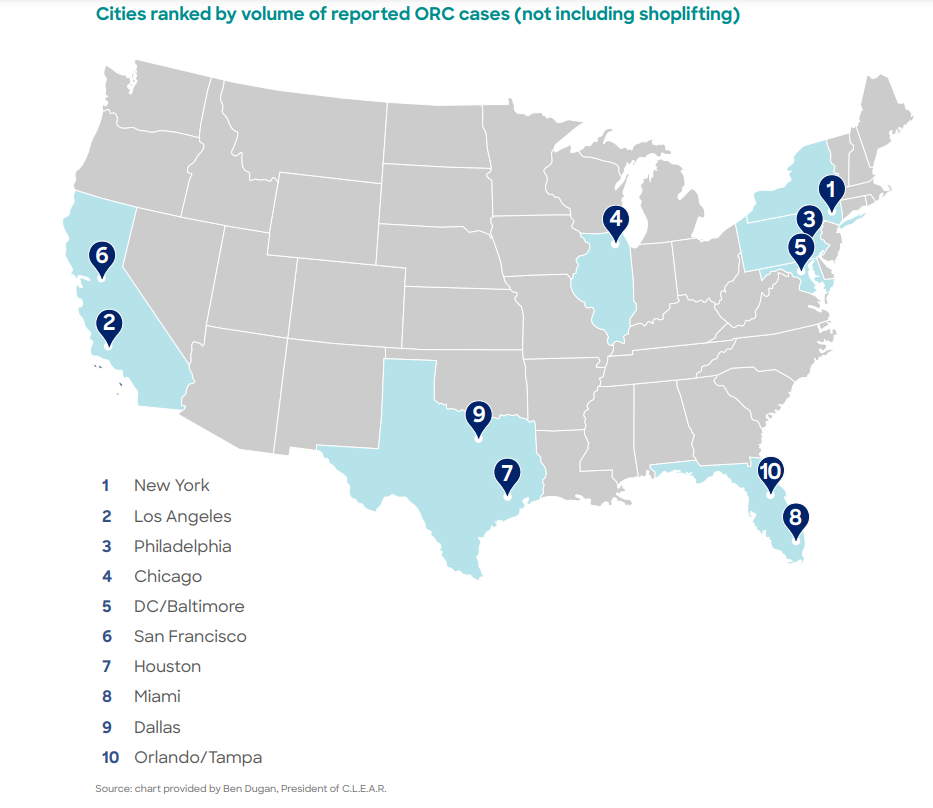
Cracking Down On Organized Retail Crime: Where Does The Financial Sector Come In?
By a Biometrica staffer
Late last November, about 80 people barged into a Nordstrom department store in the East Bay Area city of Walnut Creek in California, stealing merchandise until police arrived and arrested three of them. That was but one of a string of “smash-and-grab” robberies that hit luxury retailers in California and Illinois in the run up to the holiday shopping season in 2021. Although the spike in organized crime before the holiday season wasn’t new, retail crime experts had expressed that it had become more aggressive in recent years, per a Reuters report from last year. One expert had said that the groups behind the robberies were “sophisticated organizations” and not “your normal shoplifter.”
Law enforcement authorities had also expressed their alarm at the “brazen nature of the burglaries” last year, including the number of people it involved in some cases. To help combat organized retail crime, the Homeland Security Investigations (HSI) and the Association of Certified Anti-Money Laundering Specialists (ACAMS) have formed a partnership and published a report last week. This type of crime has become an increased threat to public safety and economy, they say. In this piece, we’ll examine some key highlights from the HSI-ACAMS report on the definition of organized retail crime (ORC) and organized theft groups (OTG), and why it matters to financial institutions.
What Is ORC?
In simple terms, ORC is the large-scale theft of retail merchandise with the intent to resell items for financial gain. The more formal definition for it, according to the Washington Organized Retail Crime Association (WAORCA) is: “the theft/fraud activity conducted with the intent to convert illegally obtained merchandise, cargo, cash, or cash equivalent into financial gain when the following elements are present: occurs over multiple occurrences OR in multiple jurisdictions, conducted by two or more persons or an individual acting in dual roles (booster and fencer).”
The HSI-ACAMS report says that ORC syndicates typically plan attacks on highly sought-after goods and then look to sell them either through backdoor and online marketplaces, or in many cases through apparently, legitimate business fronts, operating in plain sight. A common misconception among the general public is to label all retail thefts as shoplifting cases that only pose challenges to retailers.
But, this is not the case of a mother who cannot afford baby formula, for instance, the report stresses. It even goes on to add that ORC is also not necessarily those “smash-and-grab” cases that make headlines. ORC is a type of crime that involves professional OTGs, i.e. transnational criminal networks of individuals working together to steal for profit to finance their on-going operation and other criminal activities.
“Many of the criminal rings orchestrating these thefts are also involved in other serious criminal activity such as human trafficking, narcotics trafficking, weapon trafficking, and more. Tackling this growing threat is important to the safety of store employees, customers, and communities across the country.”
Steve Francis,
Acting Executive Associate Director, Homeland Security Investigations is quoted as saying in the HSI-ACAMS report
How is ORC different from burglary and larceny (such as shoplifting)?
It is not the result of a single individual breaking the law, but rather part of an organized scheme to defraud retailers or to steal products for resale elsewhere, the report says. That’s why ORC syndicates focus on high value branded items like: leather goods, over-the-counter medications, health and beauty products, designer clothing and power tools. Most consumers who finally end up purchasing these stolen goods may not even be aware that they’re buying burgled merchandise.

C.L.E.A.R stands for the Coalition of Law Enforcement and Retail
The Financial Cost Of ORC
There’s no clear-cut number on how much damage ORC does to the economy. But, most estimate that the total impact is around $69 billion annually, the report says. That number amounts to about 1.5% of total retail sales in the country. To add to it, retail theft costs federal and state governments nearly $15 billion in personal and business tax revenues, not including the lost sales taxes.
Another estimate says that the average American family will pay over $500 annually in additional costs arising from the impact of ORC. When it comes to retailers, ORC is estimated to cost retailers an average of $700,000 per $1 billion in sales, and three-fourths of retailers saw an increase in ORC in 2020, the report adds.
Where Do Legitimate Financial Institutions Fit In?
To answer that question, we’ll quote this line from the HSI-ACAMS report: “While retailers and law enforcement partner to investigate ORC cases and provide education on the misconceptions and misunderstandings, it is clear there is a missing link in these partnerships, and that link is financial institutions.” What does that mean?
Criminals need to launder the nearly $70 billion in proceeds that they make from ORC activities annually. And to do this, they typically turn to the formal, legitimate financial sector, unregulated payment processors, and online marketplaces. A key takeaway from the HSI-ACAMS report is that to take down OTGs and combat ORC more effectively, financial institutions must be brought into “the awareness and education triangle.”
The other two takeaways for financial institutions per the report are:
- Public-private partnerships and information sharing channels between retailers, law enforcement, and financial institutions need to be created
- As law enforcement and retailers prioritize investigations involving ORC, financial institutions should look to reasonably enhance their anti-money laundering (AML) and counter-terrorist financing (CTF) programs to detect and report illicit proceeds stemming from these crimes
Financial institutions should ensure proper controls are in place to detect and report illicit activities tied to or involving ORC, the report adds. Illicit proceeds aside, investigations in many cases have shown that ORC is related to and funds other criminal activity that financial institutions already monitor for.
Proceeds from this type of low cost, high reward crime have been used to fund further criminal activities, the report says, like:
- Drug and arms trafficking across the southern border
- Third-party money laundering for the benefit of Asian OTGs
- Possible terrorist financing through Middle Eastern OTGs and the ORChestrators (or the leader of an OTG)
- Labor trafficking of Central and South Americans forced to act as boosters and steal goods for transnational criminal organizations. Boosters are the thieves on the ground that steal (or boost) the products and often happen to be undocumented immigrants who are labor trafficked into the U.S.
- Counterfeit goods and cross-border fraud schemes
But whether ORC activity leads to, or is tied to, other criminal activities or not, a financial institution has government reporting obligations as the funds that come from ORC activities are illegal. A financial institution would be required to file a Suspicious Activity Report (SAR) if it knows, suspects, or has reason to suspect a transaction conducted or attempted by, at, or through the financial institution involves:
- funds derived from illegal activity, or attempts to disguise funds derived from illegal activity;
- is designed to evade regulations promulgated under the BSA (Bank Secrecy Act)
- lacks a business or apparent lawful purpose
- the use of the financial institution to facilitate criminal activity, including sanctions evasion
This is the first in a series of pieces Biometrica will do on the comprehensive HSI-ACAMS report. Other pieces in the series will examine the modi operandi and organizational structure of OTGs, the several red flags associated with ORC, and SAR/other AML considerations.